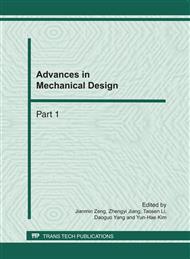p.1423
p.1429
p.1435
p.1441
p.1445
p.1451
p.1457
p.1465
p.1472
The NAVMI Factor and Natural Frequency of a Circular Plate Exposed to Water in Flexural Vibration
Abstract:
The expression of NAVMI factor and the natural frequency of a circular plate, which is placed in a hole of an infinite grid wall with one side exposed to water, are derived from the viewpoint of the additional mass. 10 Nodes Gauss-Legender integration method and the iteration method are employed to obtain the numerical results of the NAVMI factors, AVMI factors and the natural frequencies. It can be found from the results that NAVMI factors of the first two order modes are far bigger than those of the other modes when the boundary condition of a circular plate is certain. The first two order modal NAVMI factors of the circular plate with clamped and simply supported boundary conditions are far bigger than those of the circular plate with free-edged boundary condition, and the NAVMI factors are almost the same for the three order or much higher order modes regardless of the boundary condition. It is also observed that the natural frequencies of the circular plate exposed to water are smaller than those exposed to air, and the natural frequencies of the circular plate exposed to water with both sides are smaller than those of the circular plate exposed to water with one side.
Info:
Periodical:
Pages:
1445-1450
Citation:
Online since:
February 2011
Authors:
Keywords:
Price:
Сopyright:
© 2011 Trans Tech Publications Ltd. All Rights Reserved
Share:
Citation:


